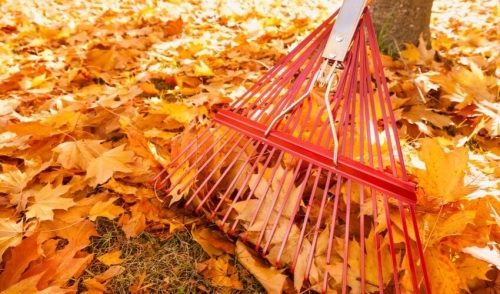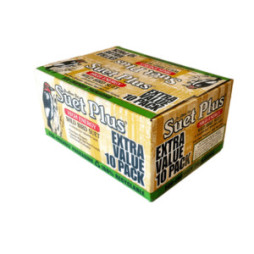With the brilliant colors of changing leaves and ripening harvests, autumn is a beautiful season, but as leaves fall and plants wilt, it is also a messy one. Fall cleanup doesn’t have to be overwhelming, however, and it is easy to keep your property in peak condition through the changing season.
Why Clean Up at All?
Falling leaves, dormant plants, and windfall fruit are natural parts of the seasonal cycle, so why is it necessary to clean them up? Autumn’s natural messes can quickly clog gutters and drains and may lead to flooding or leaks, while drooping branches can damage roofs or fences. If left untended, our lawns and flowerbeds would eventually return to a naturalized state, which may not comply with homeowner association guidelines or city ordinances. Simple fall cleanup can also make spring tasks easier, as our gardens, flowerbeds, lawns, and fields will be better prepared for work when the temperatures rise again. With so many positive outcomes thanks to a bit of autumn work, fall cleanup is well worthwhile.
25 Must-Do Tasks for Fall Yard Cleanup
The exact chores of your fall cleanup will depend what type of property you have, its overall size, the plants in your landscaping, whether you have a garden area or grow crops, and other individual concerns. Tasks you should consider for fall cleanup efforts include…
- Cleaning Out Excess Debris – Raking leaves and collecting windfall fruit will minimize the mess in your yard and leave less room for pests and fungus to develop over the winter. This is especially critical around roses and other delicate plants.
- Trim Dangerous Branches – If large branches are overhanging a roof, fence, shed, or other structure, they should be carefully removed. If left intact, these branches may continue to sag with snow and ice buildup, and can easily break and cause damage.
- Prune Properly – Even if there are no dangerous branches to trim, it may be necessary to prune trees and shrubs in autumn. This can help them keep their shape through the winter, and help train branches for the healthiest form for future growth.
- Divide Spring and Summer Perennials – The flowers, foliage, and grasses you’ve enjoyed from spring through summer can be divided and moved in autumn. Do not divide fall-blooming perennials, however, as they are still actively growing.
- Plant Fall Bulbs – Some bulbs, including daffodils, tulips, hyacinths, crocuses, and alliums, are best planted in fall and will be ready to burst forth with brilliant color in spring. It is also easier to plant bulbs in fall when flowerbeds are cleared out.
- Plant a Cover Crop – In larger gardens or commercial fields, planting a cover crop in fall will protect and enrich the soil over the winter and minimize erosion. Different types of clover, rye, and vetch are good choices, depending on your soil’s needs.
- Overseed the Lawn – If your lawn is thin or has bald, patchy spots, fall is an ideal time for overseeding to create thick, lush turf. Keep seeds moist until they have sprouted, and protect thin areas with hay to safeguard the seed as well.
- Till the Garden – After the last harvest, pull up the remnants of the summer garden and till the soil. This will reduce compaction, destroy weeds, and bring more organic material into the soil so it can thoroughly decompose over the winter.
- Compost the Garden and Beds – Adding a layer of compost or manure over the garden area and landscaping beds in fall gives the material plenty of time to break down and enrich the soil over the winter so it is ready to nourish spring plants.
- Add Insulating Mulch – A layer of mulch 3-4 inches thick can help protect roots and any perennials that have been cut back, particularly on young or delicate plants. Do not pile mulch up against woody trunks, however, or insects could infest the plants more easily.
- Protect Cold-Sensitive Plants – Very young plants or those that are particularly susceptible to cold should be protected in autumn. This may mean constructing temporary windbreaks, wrapping the plants, or using anti-transpirant sprays if needed.
- Keep Weeding – Weeding is a never-ending chore in the garden and landscape, and even after the growing season ends, it is best to continue removing weeds. The more weeds that are removed in fall, the fewer there will be to take over in spring.
- Keep Watering – Plants, especially those that are recently planted and may not yet be fully established, should continue to be watered throughout the autumn months. This will help them be as healthy and resistant to cold as possible.
- Winterize Irrigation – Once it is no longer possible or necessary to water plants, any irrigation system should be carefully winterized to minimize the risk of damage. This includes drip systems, in-ground sprinklers, hoses, and outdoor spigots.
- Consider Fall Fertilizer – Adding a root-enhancing fall fertilizer can be beneficial to your lawn and will help build strong, thick turf. Choose the fertilizer carefully, however, and follow all instructions for suitable fall use.
- Mow One Last Time – The last mowing of fall should be after lawn growth has significantly slowed or stopped, and you should mow just a bit shorter than typical. This will help the soil drain and dry out more quickly in spring.
- Aerate the Lawn – If your lawn has a thick layer of thatch or is heavily compacted, fall aeration can help it breathe again and will allow fall fertilizers or other organic material to reach the roots more quickly for healthy spring growth.
- Check Outdoor Lighting – As the days grow shorter, your outdoor lighting will be more essential. Check bulbs to be sure they are the proper size, and replace any that have burned out. Clean lighting fixtures for the best effects as well.
- Clean, Sharpen, and Store Tools Appropriately – Garden and lawn tools should be carefully maintained, and autumn is a great time to thoroughly sharpen any dull blades, tighten loose handles, or replace worn out tools with end-of-season clearance sales.
- Rotate Seasonal Tools – Rotate seasonal tools in autumn so any tools you may need in winter – snow shovels, roof rakes, snowblowers, etc. – will be easier to find and reach when you need them most.
- Clear Gutters and Drains – Inspect all gutters, downspouts, and drains and be sure they are clean and free-flowing in late autumn. This will minimize the risk of clogs and ice dams that can cause severe damage, leaks, or flooding.
- Put Away Toys and Garden Accents – Take time to put away any garden accents such as gazing balls, bird baths, decorative flags, and other items that might be damaged over the winter. Similarly, put away outdoor toys and games until they can be used again in spring.
- Clean Windows – Fall is a great time to wash the outside of windows for crisp, clean views and to let in as much sunlight as possible when daylight hours are shrinking. You may also want to clean mildew off fences and walls as needed.
- Winterize the Deck or Patio – When you can no longer use your deck or patio in late fall, it is time to cover or store patio furniture and clean the flooring so it will withstand the ravages of winter and be ready to use when the weather brightens in spring.
- Enjoy Autumn! – Despite all the fall cleanup chores that may be necessary in the yard, garden, and fields, don’t forget to simply enjoy the season. Crunch some dry leaves, taste fall fruits, breathe deep in the cool air, and have a bit of fun in this wonderful season!



Comments